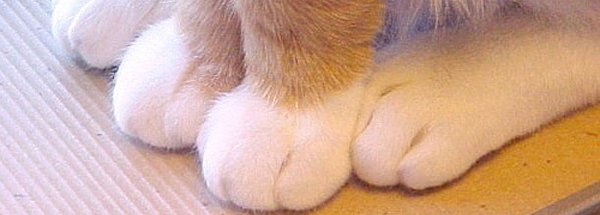Clipping Cat Nails and Training Cats to Use a Scratcher

Helping Your Cats Claw Their Way to Success
A major concern for both those who already own a cat as well as those who are considering adopting one is the issue of clawing. Let’s face it, cats do scratch! In this article, we examine the topic of scratching, and the issue of declawing surgery.
Why Cats Scratch
Scratching is a normal behavior for cats. Like their wild ancestors, domestic cats use their claws for a variety of reasons. When a cat scratches, it is meeting two very important physical needs. First, clawing stretches and tones the muscles of the feet, legs, shoulder and back.
Second, the cat’s claws regularly become frayed and scratching pulls off the outer part and exposes sharp, smooth claws.
Scratching is also an emotional behavior. It is used to mark territory. Cats have scent glands in their feet that secrete their own unique odor.
Cats do not scratch furniture and drapes to be nasty or spiteful, but in an effort to meet these needs.
Providing a Scratching Area for Your Cat
Now that you know of this natural scratching need in your furry friend, you need to channel this into a form that is acceptable to both you and your cat. You need to provide a place for your cat to scratch which is not destructive to your home. There are a number of options and sometimes you need to experiment a little.
Scratching posts are usually a good alternative. They should be sturdy and not tip over, and at least three feet tall. They should be covered in a durable material like carpeting, sisal, or thick burlap. Scratching posts are available at pet stores or through mail-order pet catalogs. You can also cover some other immobile surface (like a door or door jamb) with carpeting or the reverse side of carpeting. For multi-cat households, you may need more than one post.
Some cats have used small area rugs, fireplace logs, or cardboard boxes. The important thing is providing a medium that is acceptable to both you and your cat.
Converting Your Cat to a Confirmed Post-Scratcher
Contrary to popular thinking, cats can be taught new behaviors through positive reinforcement with some deterrent if necessary.
Applying catnip on the scratching area makes it even more irresistible to your cat.
- Dangle a toy or shoestring from the top of the post and spend some time playing with the cat around the post.
Place the post near a door or window. This is usually where cats like to mark territory. Remember, scratching is a form of marking. - Praise your cat lavishly when she uses the post. The cat needs to see the post as a fun place to be. Some cats often sit or sleep next to their post. Others begin to“show-off” for their owners by scratching the post while they are watching.
- If kitty still is not getting the idea, take her over to the post and demonstrate by scratching yourself or lay the post on its side and placing the cat on it.
- Do not do anything to startle the cat when she is hear the post.
- If your cat is extremely persistent about scratching areas where she shouldn’t, you may need to do things to make these areas less attractive to her. To make an area less attractive to the cat place double-sided tape on the object or spray it with citrus-scented air freshener. Eventually, she will tire of the area and go to the appropriate area.
- Do not scold the cat by spraying her with water or shouting at her. She will probably not associate the scolding with the object being scratched, plus you will not always be there to consistently apply the scolding. You can deter her from an area before the scratching begins by making a loud “start” noise, such as a hand clap or knock on the wall. The noise should distract her, not frighten her. Then pick her up and place her by the scratching post. Praise her if she uses the post.
You can also confine the cat for short periods of time to an area of the house with no furniture to scratch, only the scratching post. Be sure to provide food, water, toys and a litter box if you do this.
Clipping Kitty’s Nails
Keeping your cat’s claws trimmed is good grooming and will reduce the damage done by sharp nails. If possible, get the cat used to having their claws trimmed while they are still young. Never encourage a cat to play roughly with hands or feet. Instead, give them a toy to kick and claw. Trimming a cat’s claws is quick, easy, and painless to the cat when done properly.
- For best results use a clipper designed for cats. You can also use a regular nail trimmer as long as it is sharp.
- Sit quietly with the cat on your lap, floor, or table. Relax the cat by petting her. Gently hold her paw and press near the base of the nail to extend the claw.
- Clip only the very tip of the claw, away from the pink area. If you trim too closely, you may hit the veins which is painful and can cause bleeding. Clip every claw including the dewclaws on the sides of the front paws.
If you are unsure how to clip the nails, ask your veterinarian or PAWS staff to show you.
Polydactyl cats (those with extra toes) are often unable to retract their claws and need to have their extra toes clipped to prevent them from growing into the flesh. Elderly cats may also need help in keeping their claws trimmed.
Declawing
PAWS strongly encourages pet owners to seek alternatives to the declawing of cats. If you are thinking about having your pet declawed, please take a moment to consider the following information.
We have already established the important need for clawing. Clawing provides exercise to strengthen foot, leg, and back muscles of your cat. A declawed cat can no longer get this beneficial muscle toning, and muscles may atrophy sooner than with normal aging. Without her front claws, her balance is also impaired.
Declawing Surgery – The Procedure
Declaw surgery is the permanent, nonreversible amputation of the first joint of the toe. Because cats have retractable claws, not only the nail must be removed, but the cells at the claw’s base responsible for growth, part or all of the terminal bone of the toe, and sometimes part of the foot pad. It has been compared to amputation of the human finger at the uppermost joint.
Risks to the animal include adverse effects of general anesthesia, postoperative infections, excessive bleeding, long-term pain from severed nerve endings, and improper surgical technique requiring a second surgery.
Long-Term Effects of Declawing
Beside the physical effects of declawing such as decreased muscle strength and balance there are potentially a number of psychological and behavioral effects.
- The declawed cat is left without her primary defense mechanism. Cat’s usually defend themselves with their claws, not their teeth. Because the cat has little defense, they should never be allowed to go outside the home.
- Because they have no claws, they live in a constant state of stress which can make them more prone to disease or cause other behavior problems. They often become nervous, irritable, aggressive and difficult to handle. Formerly lively, friendly animals can become withdrawn and introverted.
- Declawed cats may turn into habitual biters. Left without front claws, teeth are the only way to defend themselves and they may use their teeth more frequently to defend themselves.
- Some declawed cats stop using their litter boxes because of pain in their paws. This could be temporary following surgery or permanent.
PAWS hopes that you will give careful consideration to the decision to declaw or not to declaw your cat. It is a painful procedure that can have serious physical and behavioral consequences for your pet. If you have questions about declawing or about training your cat, don’t hesitate to call us. We’ll do our best to help you establish and maintain a happy relationship with your feline friend, while keeping your furniture and pet intact.




